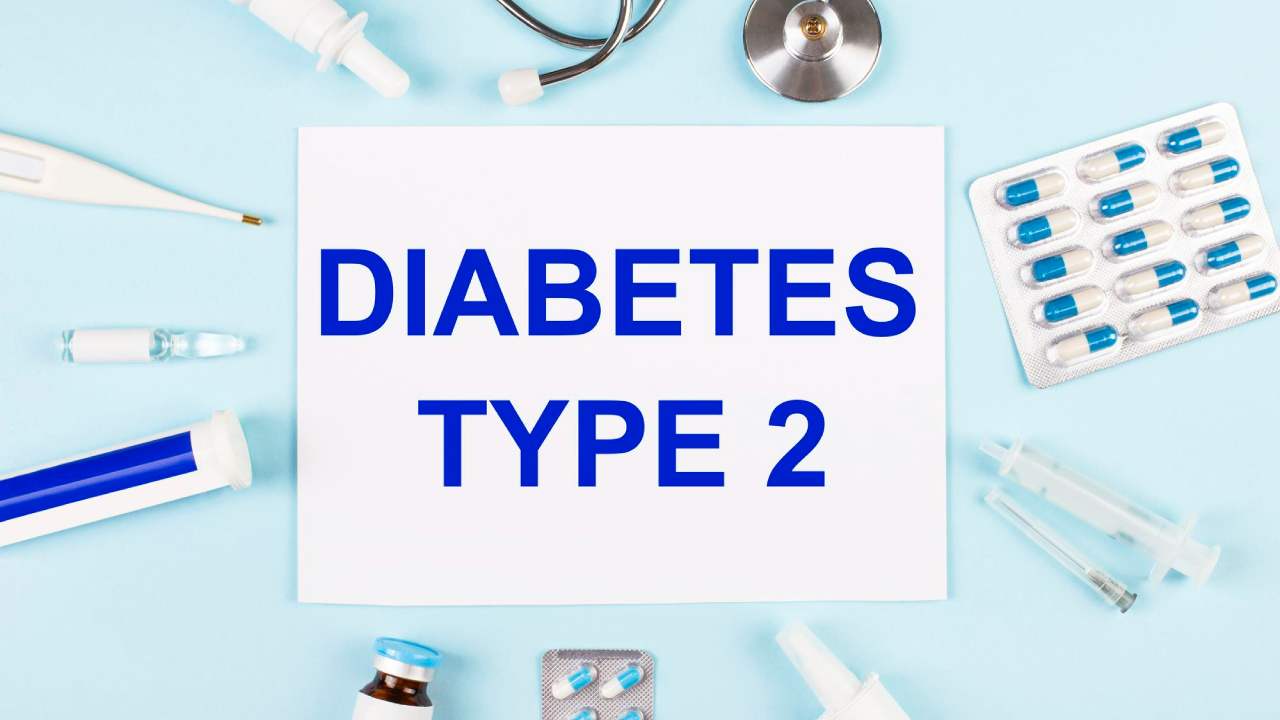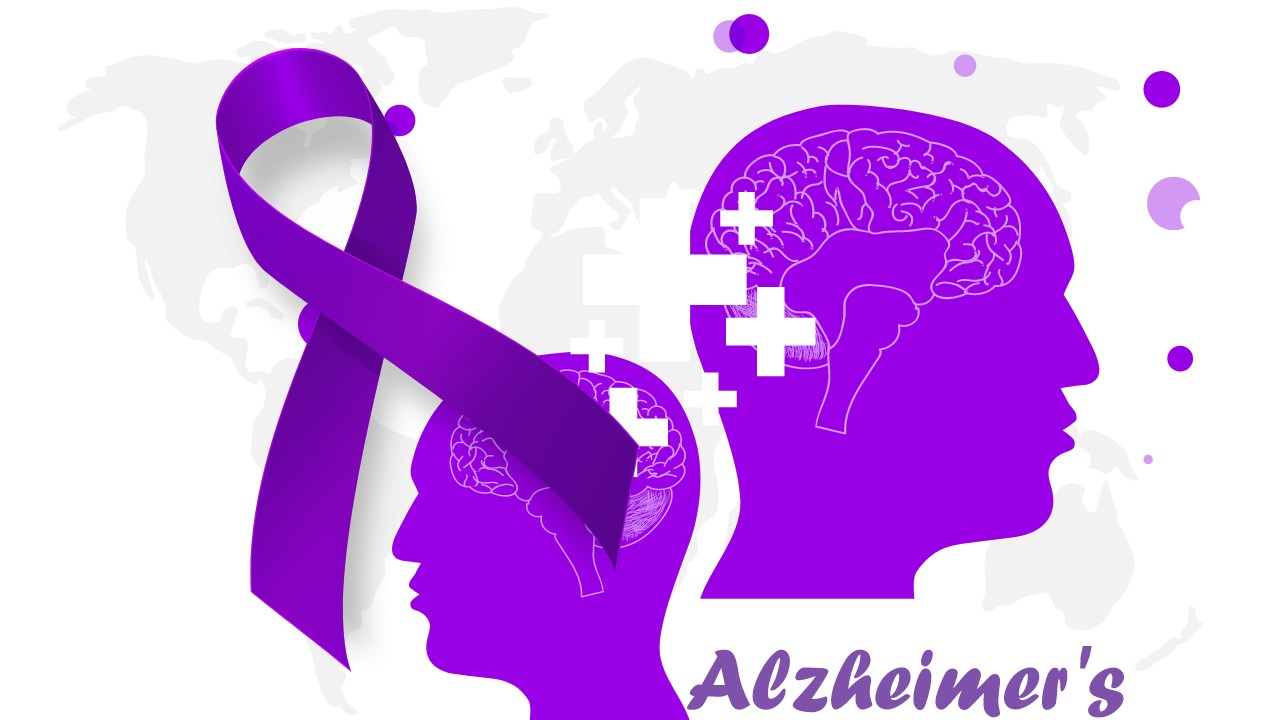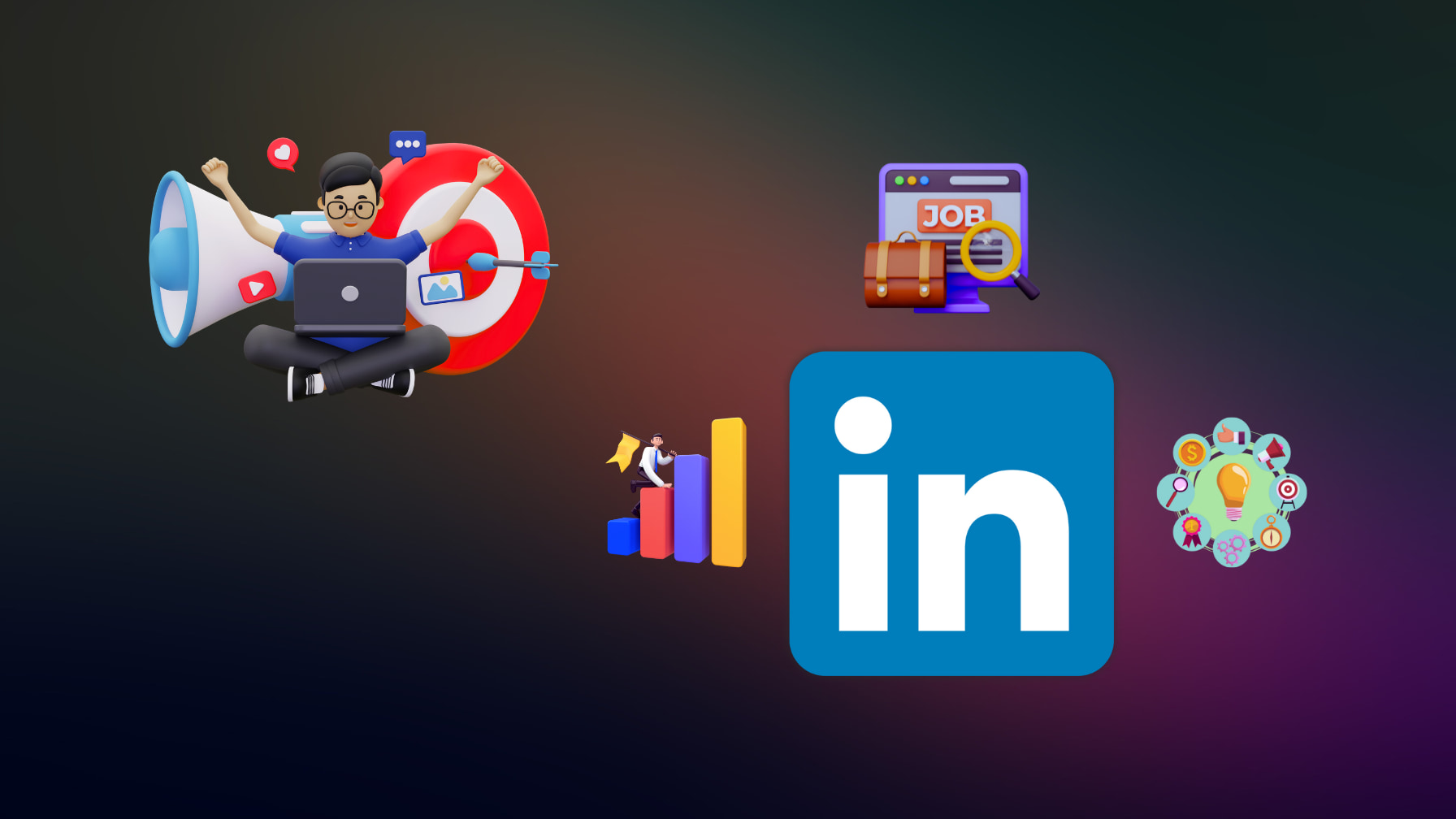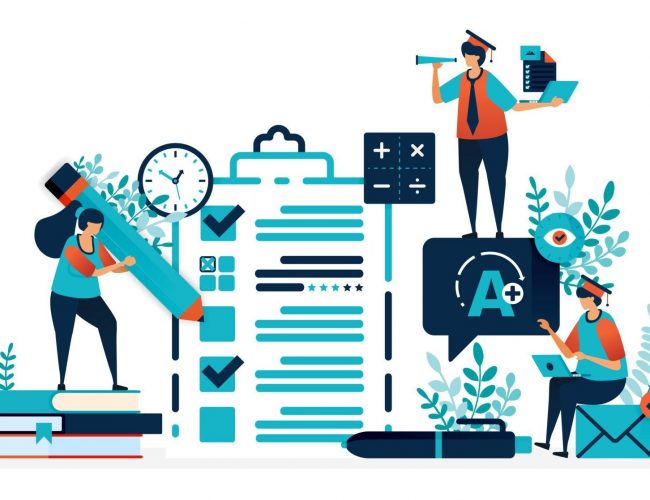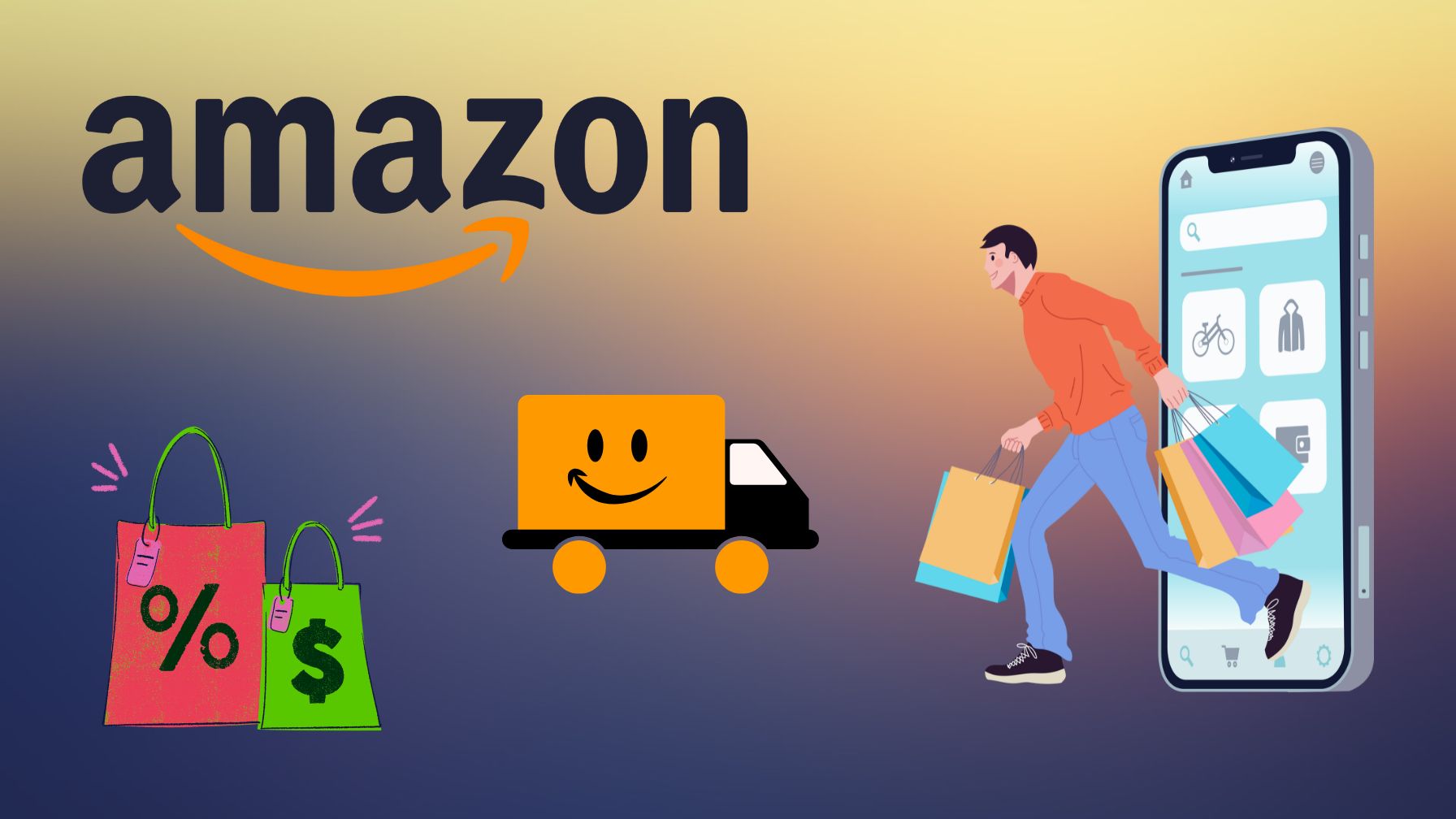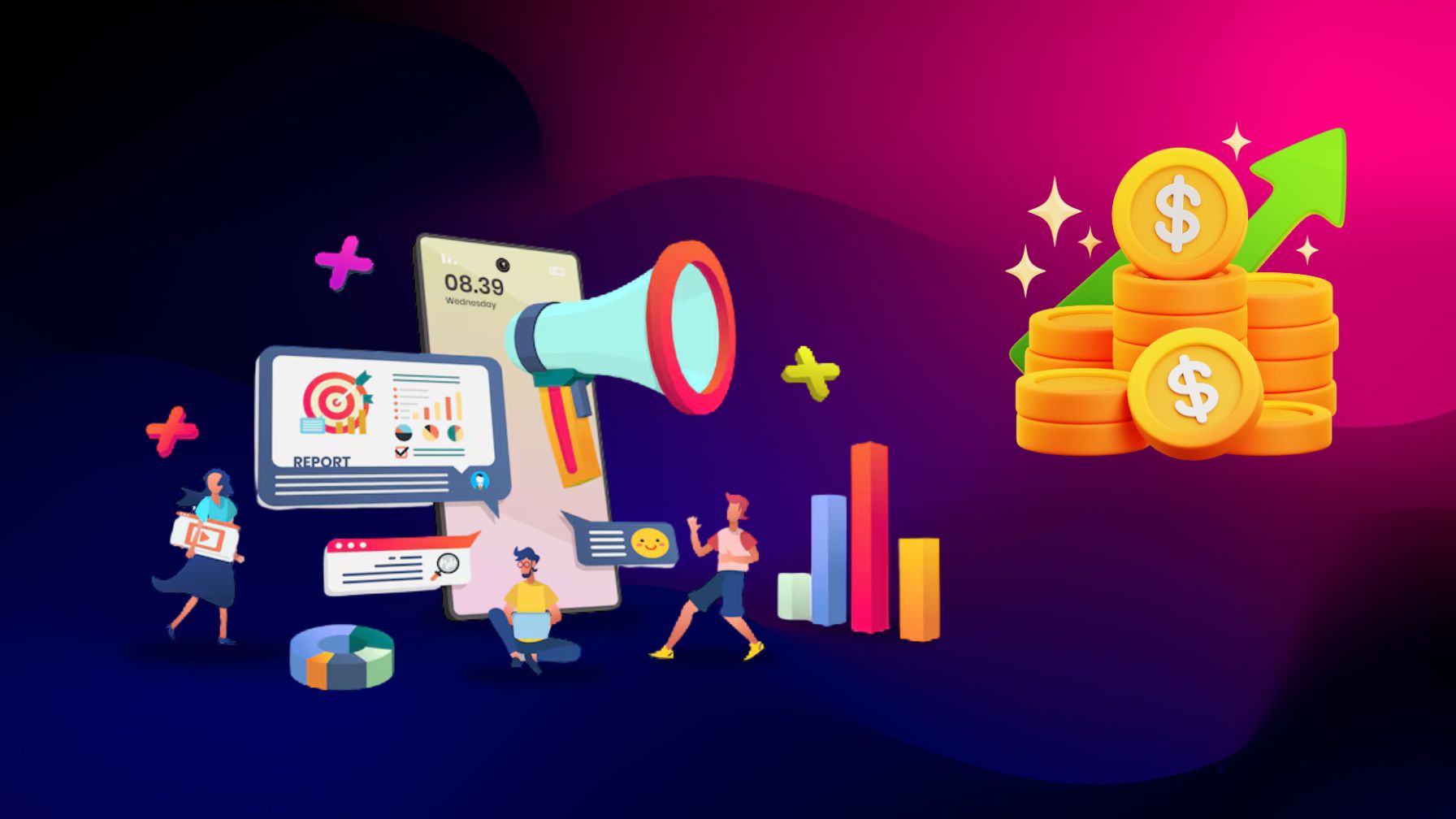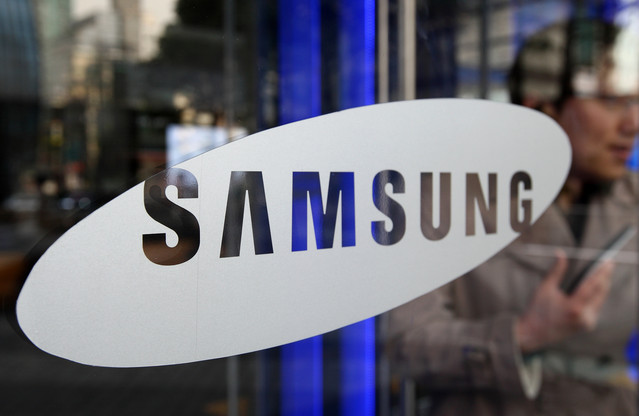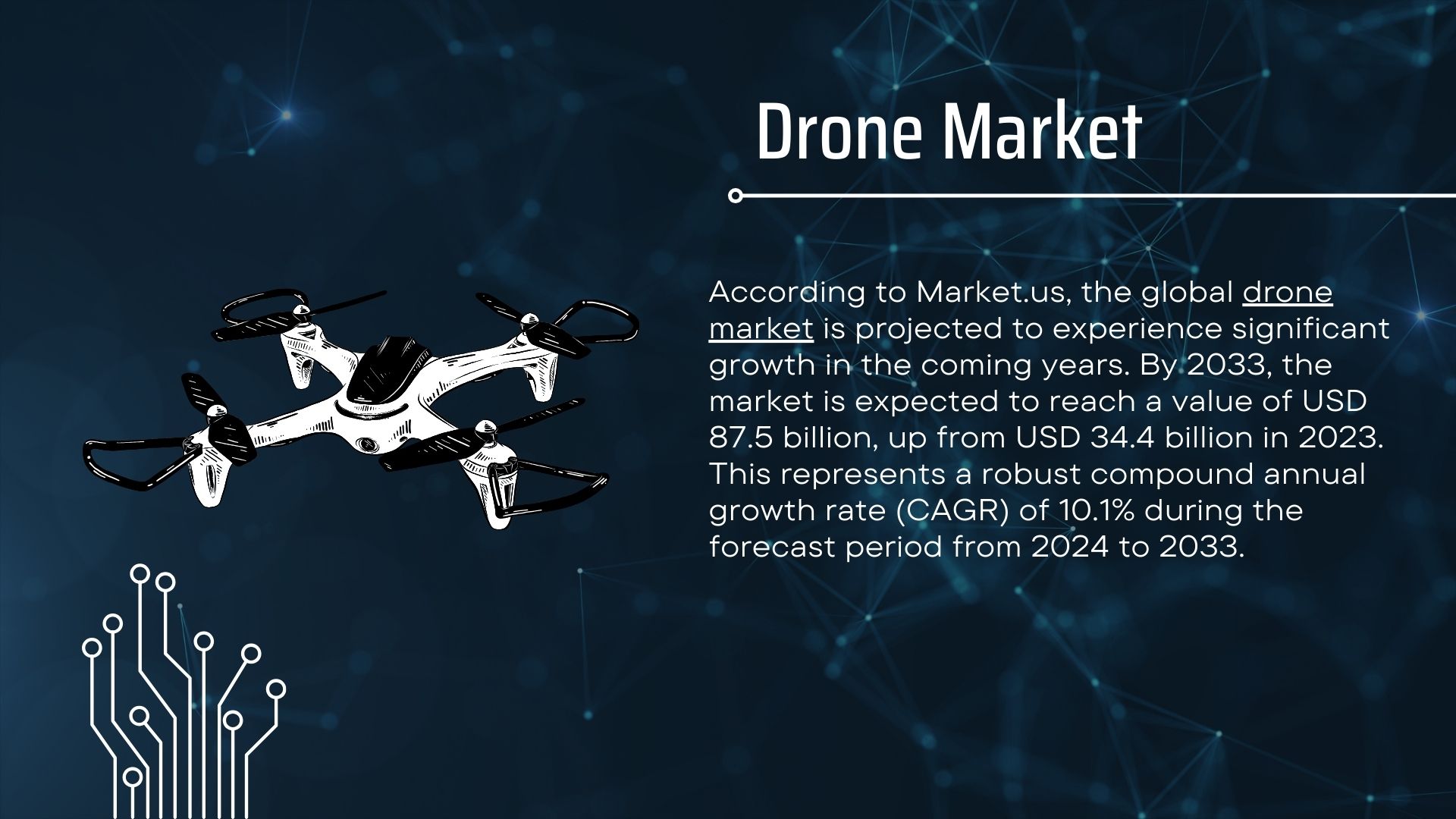WHAT WE HAVE ON THIS PAGE
- Editor’s Choice
- Top Email Marketing Personalization Tactics
- Global Adoption Rates of Personalized Email Marketing
- Email Usage
- Top Organizational Goals for B2B Content Marketing
- Mobile Email Marketing
- B2C Email Marketing
- Most Common Types of Emails Marketers Send
- Impact of Personalization on Open and Click-Through Rates
- Email Engagement
- Email Open, Click, and Bounce Rates by Industry
- Segmentation and Dynamic Content Usage Trends
- ROI of Personalized Email Campaigns Compared to Generic Emails
- Email Marketing Frequency: How Often Marketers Send Emails
- Consumer Preferences and Response to Personalized Emails
- AI and Automation in Email Personalization
- Usage of Defined Email Design Systems for Campaigns
- Industry-Specific Performance Metrics
- Challenges and Limitations in Personalized Email Marketing
- Privacy Concerns and Regulatory Compliance
- Recent Developments in Email Personalization Tools and Techniques
- Conclusion
- Sources
In the cluttered world of inboxes, there’s one thing that still manages to stand out: a message that feels like it was written just for you. Picture this: You open your email, and the subject line includes your name. Inside, there’s a product recommendation based on what you browsed last week. It’s relevant. It’s timely. And it makes you want to click.
That’s the power of personalized email marketing, a strategy that’s evolved from “Hello [First Name]” to full-scale behavioral targeting. In 2025, personalization is no longer a nice-to-have; it’s the backbone of effective digital engagement. Whether you’re a startup or an enterprise, understanding these latest trends can help shape smarter strategies and better returns.
Editor’s Choice
- 86% of marketers report a boost in email performance due to personalization in 2025.
- Emails with personalized subject lines are now seeing up to 35% higher open rates in 2025.
- Dynamic content blocks are used by 73% of email campaigns to tailor messages in real-time.
- Behavior-based segmentation led to a 19% increase in conversions on average in early 2025.
- 56% of consumers say they are more likely to become repeat buyers after receiving personalized emails.
- Triggered emails, like cart abandonment or product browse, now drive 3x more revenue than batch-and-blast campaigns.
- The average ROI for personalized email campaigns reached $52 for every $1 spent in Q1 2025.
Top Email Marketing Personalization Tactics
- Email list segmentation is the leading tactic, used by 51% of marketers to personalize campaigns and boost relevance.
- Individualized email messaging follows closely at 50%, emphasizing the value of tailored communication.
- Behavior-triggered emails are used by 45%, responding to user actions in real time for improved engagement.
- Responsive email design is implemented by 34%, ensuring emails display well across all devices.
- Social media integration is part of personalization strategies for 30% of marketers.
- Individualized landing pages are used by 27%, allowing for a seamless and customized user journey.
- Self-managed preference centers are offered by 26%, giving users control over the content they receive.
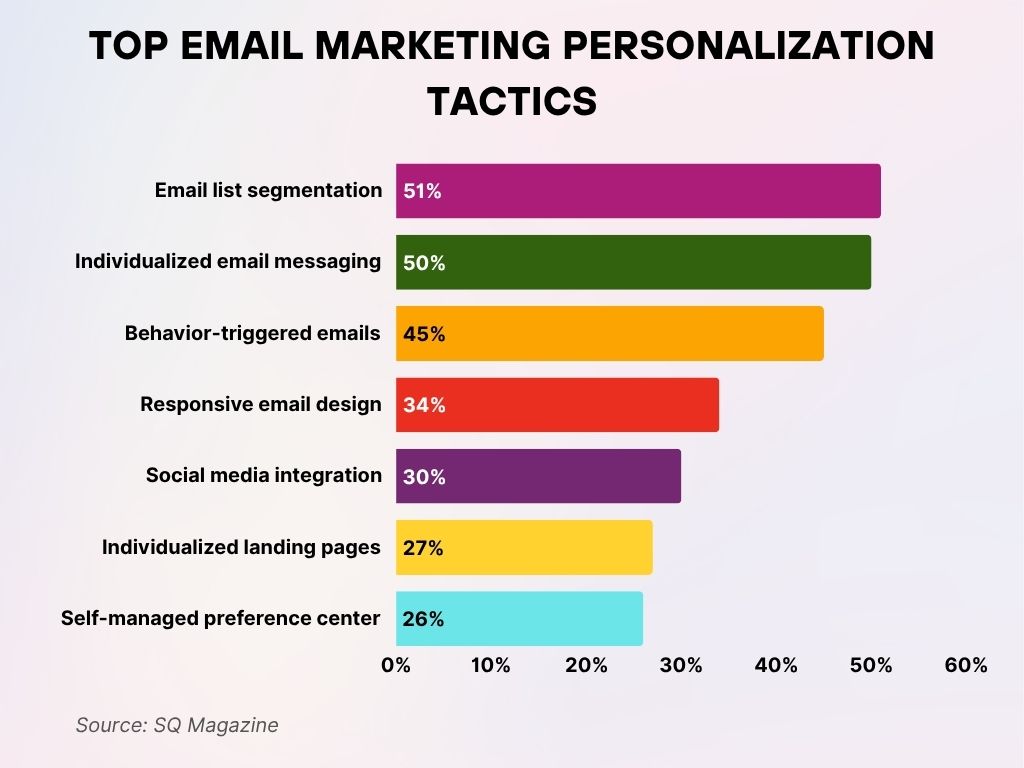
Global Adoption Rates of Personalized Email Marketing
- As of 2025, 91% of global brands use some form of personalization in email marketing.
- North America leads adoption, with 97% of email marketers integrating personalization tools into their stack.
- Western Europe follows closely, with 89% adoption, while APAC sits at 82%.
- In Latin America, usage has grown by 14% year-over-year, reaching 71% in early 2025.
- Companies with over 500 employees are 3.7 times more likely to use advanced personalization than smaller businesses.
- 49% of global retailers say personalized emails are their top-performing channel.
- AI-driven personalization solutions are currently used by 64% of enterprise marketing teams worldwide.
Email Usage
- In 2025, there will be 4.6 billion email users globally.
- The average person receives 121 emails daily, but only engages with 15-20% of them, making personalization vital.
- 58% of consumers check their email before 9 AM, often via mobile, impacting send-time strategies.
- Transactional emails continue to outperform, with 82% open rates and 48% click-through rates when personalized.
- B2C brands send on average 5.8 personalized emails per user per month.
- 90% of Gen Z users prefer brands that offer personalized experiences over generic outreach.
- The use of email retargeting based on past interactions has grown by 28% year-over-year in 2025.
- Over 65% of SMBs consider email their most critical digital channel, especially when personalization is applied.
Top Organizational Goals for B2B Content Marketing
- Lead Generation is the top goal for 85% of organizations, highlighting its critical role in driving business growth.
- Sales come in second at 84%, showing the direct link between content marketing and revenue generation.
- Lead Nurturing is a priority for 78%, aiming to guide prospects through the buying journey.
- Brand Awareness is essential for 77% of businesses, helping establish market presence and credibility.
- Engagement is key for 76%, focusing on building meaningful customer interactions.
- Customer Retention/Loyalty is targeted by 74%, reflecting the value of long-term relationships.
- Customer Evangelism/Brand Advocacy is important for 61%, leveraging satisfied customers to spread positive word-of-mouth.
- Upsell/Cross-sell opportunities are pursued by 58%, aiming to increase customer lifetime value.
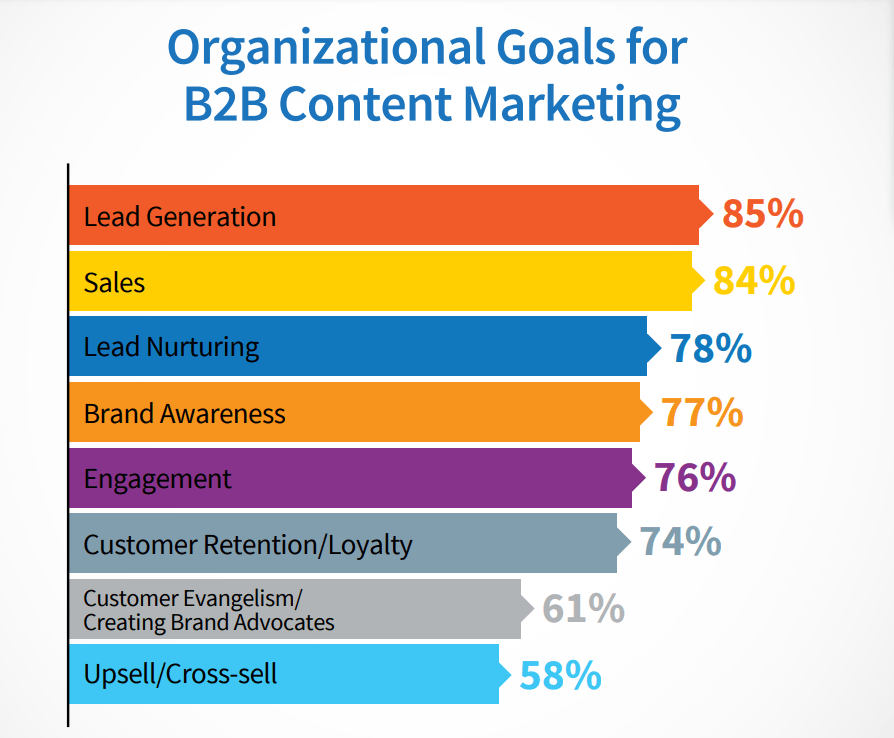
Mobile Email Marketing
- 81% of emails are now opened on mobile devices, and that number continues to edge upward in 2025.
- Personalized mobile email campaigns deliver 29% higher engagement than non-personalized ones.
- The average click-to-open rate on mobile for personalized emails is 16.8%, compared to 11.3% for static emails.
- 42% of users will delete emails not optimized for mobile, regardless of the offer.
- Interactive elements like tap-to-reveal offers and personalized image carousels are used by 37% of mobile campaigns in 2025.
- Dark mode-optimized emails with dynamic personalization have a 14% lower unsubscribe rate.
- Geo-targeted personalization on mobile has shown a 21% increase in foot traffic for local businesses.
- The average session time spent engaging with a personalized mobile email is 15.2 seconds, compared to 8.6 seconds for generic messages.
B2C Email Marketing
- In 2025, 92% of B2C marketers use personalization in at least one email campaign every month.
- Cart abandonment emails with product images and customer names now recover an average of 22% of lost sales.
- Recommendation engines integrated into emails drive 33% of B2C email revenue.
- Personalized B2C promotional emails lead to 38% more transactions than generic batch emails.
- Birthday and anniversary emails, tailored with unique offers, generate 481% higher transaction rates.
- Lifestyle-based segmentation (e.g., health-conscious, pet owners, tech-savvy) has increased email ROI by 27%.
- B2C brands that send localized emails using ZIP code or weather-based data report a 21% increase in engagement.
- Flash sales promoted with customer-specific preferences see 3.1x more conversions than untargeted ones.
- Millennials and Gen Z show a 72% preference for emails featuring their browsing or purchase history.
- Loyalty programs that use personalized emails based on reward status have a 49% higher reactivation rate for dormant users.
Most Common Types of Emails Marketers Send
- Newsletters top the list, sent by 81% of marketers to keep audiences informed and engaged.
- Welcome emails follow at 79%, helping build immediate rapport with new subscribers.
- Product-related emails are sent by 75%, highlighting new offerings and updates.
- Sales or promotional emails are used by 72% to drive conversions and time-sensitive deals.
- Event emails are sent by 71%, promoting webinars, launches, or in-person events.
- Onboarding or post-purchase emails are used by 62% to guide customers after a transaction.
- Customer winback emails are utilized by 45%, aiming to re-engage lapsed customers.
- Blog emails are distributed by 43%, sharing new content to drive traffic and SEO.
- Subscriber re-engagement emails are sent by 41%, reviving inactive contacts.
- Cart or browse abandonment emails are used by 35% to recover potential lost sales.
- Milestone emails (e.g., birthday, anniversary) are used by 31% to personalize experiences.
- NPS or review request emails are sent by 29%, gathering customer feedback and insights.
- Service reminders or replenishment emails are used by 27%, especially in subscription models.
- Back-in-stock or waitlist emails are the least common at 14%, yet crucial for high-demand items.
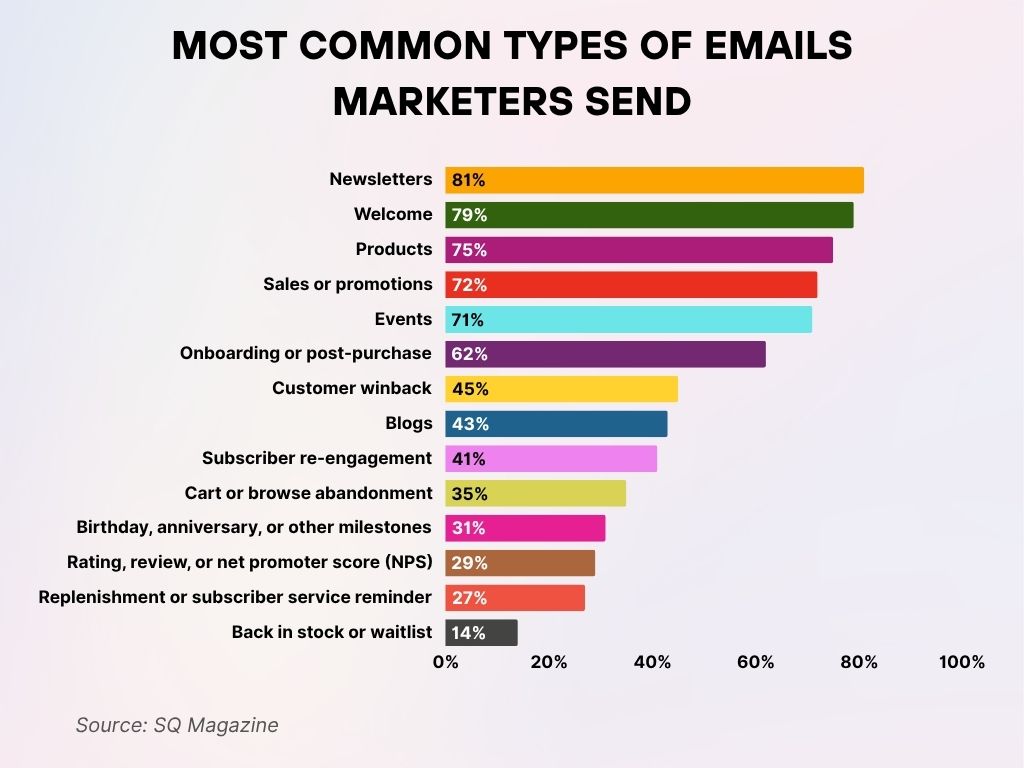
Impact of Personalization on Open and Click-Through Rates
- Personalized subject lines lead to an average open rate of 29.6%, compared to 18.1% for non-personalized ones in 2025.
- Emails segmented by past behavior (click history, purchases) report 41% higher click-through rates (CTR).
- Using first names in subject lines still works, contributing to a 14% higher open rate on average.
- Emails with personalized calls to action (CTAs) have a 202% improvement in click-through performance.
- A/B testing personalization variables (e.g., product suggestions vs. generic offers) has become standard practice for 68% of marketers.
- Interactive elements like countdown timers or stock-level indicators tailored to customer interest increase CTR by 26%.
- Marketers using AI-optimized send times based on user activity see 2x click performance compared to manual send times.
- Interest-based segmentation, like favorite categories or viewed content, boosts email dwell time by 44%.
- Personalized email footers (location-specific store info, contact details) increase CTR by 11%, especially in retail.
- Real-time product personalization (updating email content at open time) has lifted click-to-conversion rates by 33%.
Email Engagement
- Email campaigns with personalized content see an average read time of 13.4 seconds.
- Personalized email experiences have reduced bounce rates by 18% year-over-year.
- Emotionally resonant messaging (using customer personas) improves engagement by 39%.
- 25% of subscribers are more likely to forward or share a personalized email than a generic one.
- Personalized re-engagement emails revive dormant subscribers at a 16.7% higher rate.
- Interactive personalized quizzes embedded in emails report 50% higher completion rates than static surveys.
- Emails that address users’ last purchase date and suggest next steps increase repeat engagement by 21%.
- Behavior-triggered follow-up emails have a 3.6x higher interaction rate than scheduled newsletters.
- Live content, such as weather updates or real-time pricing, tied to user context, improves engagement by 28%.
- Personality-based segmentation (e.g., introvert vs. extrovert shopping habits) is an emerging trend, growing 12% in use year-over-year.
Email Open, Click, and Bounce Rates by Industry
- Nonprofits lead with the highest open rate (30%), showing strong subscriber engagement, and have one of the lowest bounce rates.
- Real Estate and Restaurants & Food follow with open rates close to 28–29%, suggesting highly effective email strategies.
- Agencies and Technology have solid open rates (26–27%), but click rates are moderate across all sectors.
- Travel has one of the lowest open rates (23%) but a notably higher bounce rate, indicating deliverability issues.
- Internet Marketing and Financial Services have open rates below 25%, with Financial Services showing relatively higher bounce rates.
- Retail and Restaurants & Food maintain good open rates and lower bounce rates, reflecting a reliable audience reach.
- Click rates across all industries are considerably lower than open rates, generally hovering around 2–4%.
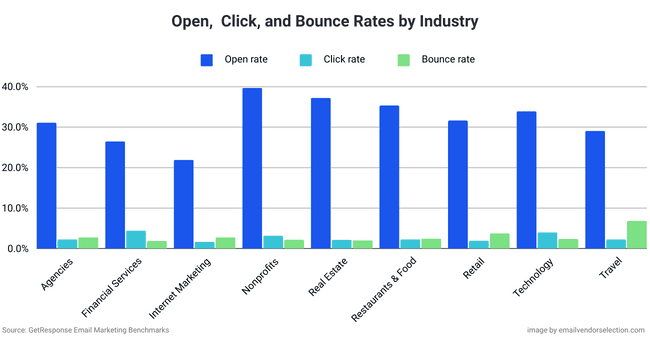
Segmentation and Dynamic Content Usage Trends
- 68% of email marketers in 2025 use 3 or more audience segments in each campaign.
- Campaigns using dynamic product content have 2.4x higher ROI than static ones.
- 79% of brands use demographic segmentation (age, gender, income level) in their email workflows.
- Behavioral segmentation (purchase history, browsing behavior) is used in 72% of personalized campaigns.
- Advanced segmentation tools (like predictive intent modeling) are used by 44% of enterprise marketers.
- Dynamic pricing modules personalized by user segment are now used in 1 in 4 ecommerce emails.
- Multivariate personalization, adjusting multiple content blocks by persona, is up 33% year-over-year.
- Time-zone-based segmentation improves open rates by 17%, especially in global campaigns.
- Retailers using lifecycle-based segmentation (first-time buyer, repeat customer, lapsed) show 27% higher retention rates.
- Dynamic personalization driven by psychographic data (attitudes, lifestyle) is a growing trend among fashion and lifestyle brands.
ROI of Personalized Email Campaigns Compared to Generic Emails
- Personalized campaigns drive an average ROI of $52 per $1 spent, versus $19 for non-personalized.
- Brands using deep personalization (real-time behavior, AI segmentation) see 289% more revenue than basic personalization users.
- Transactional emails that include dynamic cross-sells contribute to 20% of total email revenue.
- Abandoned cart emails with personalized incentives recover up to 30% more revenue than those with static offers.
- Upsell and loyalty emails personalized by purchase frequency lead to a 43% increase in customer lifetime value (CLV).
- Email campaigns using AI-driven product recommendations yield 25% more revenue per email sent.
- Customer journey mapping to personalize email touchpoints boosts funnel efficiency by 32%.
- Retailers integrating customer feedback loops into email personalization strategies report a 17% cost reduction in acquisition.
- Subscription brands using personalized churn-prevention emails report a 21% lower monthly churn rate.
- B2C companies with personalized email automation report revenue growth that’s 1.8x faster than their peers.
Email Marketing Frequency: How Often Marketers Send Emails
- 22% of marketers send emails 2–3 times per day, showing an aggressive engagement strategy.
- 21% send emails daily, maintaining a consistent brand presence in inboxes.
- 17% opt for 3–4 times per week, balancing frequency with content quality.
- 12% prefer a weekly schedule, offering regular updates without overwhelming subscribers.
- 10% send marketing emails 2 times per week, aiming for a moderate outreach approach.
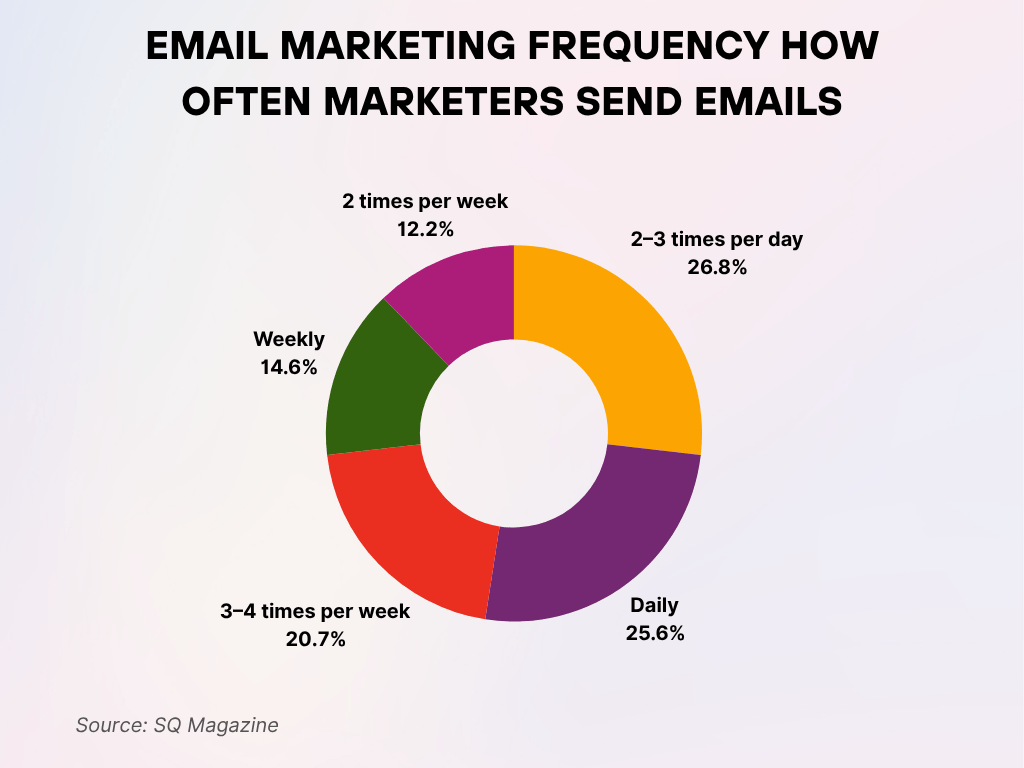
Consumer Preferences and Response to Personalized Emails
- In 2025, 74% of consumers say they feel “frustrated” when an email feels irrelevant or impersonal.
- 82% of users are more likely to open emails from brands that tailor content based on their previous interactions.
- 61% of consumers state that personalized emails make them feel more valued by the brand.
- 49% of email recipients made an impulse purchase after receiving a highly personalized message.
- Emails using a customer’s first name and local context (e.g., “Looks like rain today in Chicago…”) saw a 42% lift in engagement.
- 42% of Gen Z shoppers expect brands to know their preferences and send emails that reflect them.
- Personalized post-purchase emails that include how-to tips or setup guides increase customer satisfaction by 35%.
- 51% of Americans say they are more likely to become loyal to a brand that provides personalized content regularly.
- Consumers unsubscribe 3x less frequently from personalized email sequences than from general campaigns.
- Preference-based opt-ins, where users select what content they want to receive, now drive 28% more email engagement.
AI and Automation in Email Personalization
- 65% of marketers are now using AI-powered tools to automate email personalization at scale in 2025.
- AI-generated subject lines based on user sentiment analysis increase open rates by 21%.
- Natural language generation (NLG) tools are used by 38% of email teams to create hyper-personalized product descriptions.
- Predictive analytics allows marketers to anticipate the best time to send, resulting in up to 42% better open rates.
- Automation workflows now adapt in real time based on user engagement patterns, increasing conversion potential by 26%.
- AI-driven A/B/n testing is used by 1 in 3 enterprise teams to test multiple personalization strategies at once.
- Smart segmentation powered by machine learning has reduced manual list-building time by over 50%.
- Email copywriters are now collaborating with AI tools to craft subject lines and body content tailored to micro-segments.
- Tools like Persado and Phrasee are commonly used for real-time content optimization in large campaigns.
- AI-powered personalization has allowed retargeting emails to become 4x more effective than generic retargeting efforts.
Usage of Defined Email Design Systems for Campaigns
- 38.2% of respondents sometimes use a defined email design system for building campaigns, showing flexible but inconsistent practices.
- 36.2% said yes, always, indicating strong adoption of standardized email design systems.
- 19.9% reported no, never, revealing a notable portion of teams that do not use any design framework.
- 5.7% responded with I don’t know, suggesting uncertainty or lack of involvement in the process.

Industry-Specific Performance Metrics
- E-commerce brands see the highest ROI from personalized email, averaging $62 per $1 spent.
- Healthcare providers using appointment reminders with patient-specific details see 78% open rates.
- Financial institutions leveraging transaction-based personalization report click-through rates of 21.5%.
- Travel and hospitality emails personalized by trip history or preferences achieve 18% higher booking rates.
- Education platforms sending course progress updates with personalization see 2.3x re-enrollment rates.
- In the fitness industry, emails tied to personal goals (e.g., workout milestones) yield 47% more app opens.
- Retail brands using real-time product availability and store locator features in emails report a 16% boost in foot traffic.
- SaaS companies using onboarding emails personalized by user role or use case see 35% higher activation rates.
- Restaurants and food services sending localized deals based on past orders have a 25% order increase.
- Subscription boxes using renewal reminder emails that mention preferred products reduce churn by 18%.
Challenges and Limitations in Personalized Email Marketing
- 42% of marketers cite data quality as their top barrier to effective personalization in 2025.
- Integrating CRM and email platforms remains a challenge for 29% of mid-sized businesses.
- Only 58% of personalization campaigns are properly optimized for mobile, leading to lost engagement opportunities.
- Lack of skilled personnel to manage AI-driven personalization is a hurdle for 1 in 4 companies.
- Data silos within large organizations result in fragmented customer profiles in 35% of cases.
- Personalization fatigue is emerging, 17% of users express annoyance at over-personalized or “creepy” emails.
- Latency issues with dynamic content delivery impact 11% of emails, especially during high-volume campaigns.
- Over-segmentation can backfire: marketers managing more than 20 segments report a drop in efficiency.
- 60% of marketers are still not using behavioral triggers, missing out on timely engagement windows.
- A/B testing personalization tactics is underutilized; only 39% do it consistently.
Privacy Concerns and Regulatory Compliance
- In 2025, 71% of US consumers say they’re concerned about how their data is used in email personalization.
- The introduction of state-level privacy laws like CPRA (California), CPA (Colorado), and CTDPA (Connecticut) requires explicit opt-in for data usage in email personalization.
- Only 54% of marketers claim full compliance with evolving global data regulations such as GDPR, CAN-SPAM, and newer state laws.
- Double opt-in email signups have increased by 32% year-over-year to meet privacy compliance.
- 31% of brands now include personalization preference centers, allowing users to manage what data they share.
- Email anonymization (e.g., through Apple Mail Privacy Protection) has limited access to open data for 23% of marketers.
- AI compliance audits are being conducted quarterly by 12% of enterprise email teams.
- 28% of email marketers now employ zero-party data strategies (where users voluntarily provide data) as a privacy-friendly personalization approach.
- 42% of marketers have updated their personalization practices due to recent enforcement actions and fines.
- Compliance with email-specific consent protocols (like purpose-based opt-in) has become a core KPI for legal and marketing teams.
Recent Developments in Email Personalization Tools and Techniques
- AI copy tools like Jasper, Copy.ai, and ChatGPT are being integrated into 30% of ESPs for smart personalization at scale.
- Email personalization APIs are now used by 41% of enterprise marketers to embed real-time dynamic content.
- Visual personalization, like personalized product imagery, is up 43% in usage in e-commerce.
- No-code personalization platforms such as Iterable and ActiveCampaign are popular with small teams and solopreneurs.
- AMP for Email adoption grows in 2025, enabling real-time forms, polls, and carousels, used in 11% of campaigns.
- Hyper-personalized video emails are an emerging trend, especially in real estate and B2B sales outreach.
- Machine learning-based predictive content engines are used to populate entire emails with user-specific messages in real time.
- Dynamic email previews, which update based on open time, location, or device, are gaining traction in retail.
- Augmented reality email previews (AR emails) are being tested by major fashion brands for interactive try-on experiences.
- Browser history-integrated personalization is emerging, although limited by privacy regulations, expected to grow cautiously with consent-based models.
Conclusion
In 2025, personalized email marketing is no longer an experiment, it’s the engine that drives deeper engagement, stronger loyalty, and higher ROI across nearly every industry. The brands that win are those that combine data, technology, and empathy to deliver experiences that matter. As regulations tighten and consumer expectations grow, striking the right balance between relevance and respect will be essential.
Investing in smarter personalization tools, honoring privacy, and focusing on authenticity over automation can turn your emails from overlooked to unforgettable.
Sources
- https://www.forbes.com/advisor/business/software/email-marketing-statistics/
- https://www.mailmodo.com/guides/personalized-email-marketing-statistics/
- https://www.shopify.com/ph/blog/email-marketing-statistics
- https://optinmonster.com/email-marketing-statistics/
- https://www.campaignmonitor.com/resources/infographics/24-email-marketing-stats-need-know/
- https://stripo.email/blog/personalized-email-marketing-statistics-why-tailored-campaigns-drive-results/
- https://www.getresponse.com/blog/email-marketing-statistics
- https://mailchimp.com/resources/email-marketing-benchmarks/

